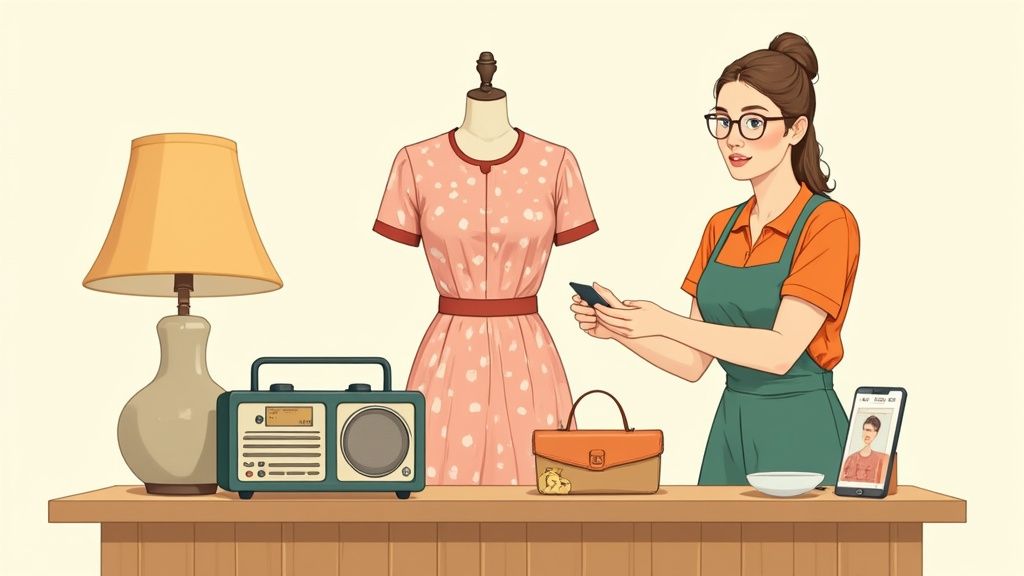Selling vintage isn't just about clearing out your attic; it's about unearthing treasures and connecting them with people who will cherish them. It’s a unique blend of being a historian, a curator, and a savvy business owner, all while promoting a more sustainable way to shop.
The Enduring Appeal of Selling Vintage Items
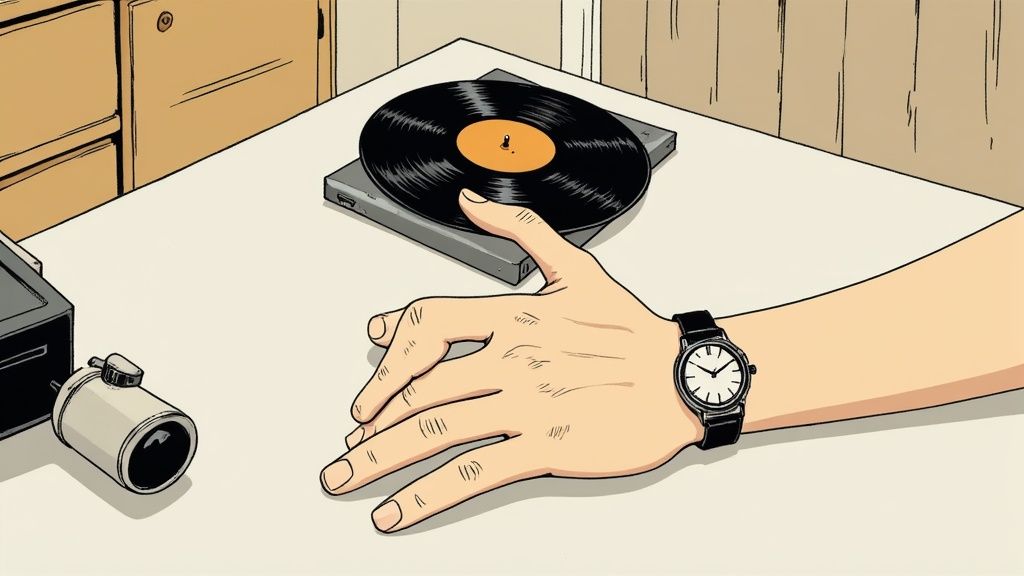 You know that feeling when you spot something special at a flea market? That immediate connection to an object with a past? Millions of people share that exact feeling, and it’s completely changing the way we think about shopping.
You know that feeling when you spot something special at a flea market? That immediate connection to an object with a past? Millions of people share that exact feeling, and it’s completely changing the way we think about shopping.
Consumers are actively moving away from the endless cycle of mass-produced, cookie-cutter products. They're looking for items that have character, a story, and a quality that’s hard to find on modern retail shelves. This isn't just some passing fad—it's a real and powerful shift in consumer behavior.
For anyone with a good eye, this shift is a golden opportunity. Learning how to sell vintage items lets you tap directly into this growing demand. You get to build a business that celebrates sustainability and individuality, all while connecting with buyers who truly appreciate the history behind each piece.
Why Vintage Sells So Well Now
So, what’s behind this vintage boom? A few key things are driving it. The biggest push is sustainability. As people become more conscious of the environmental toll of "fast fashion" and throwaway culture, they're searching for better alternatives. Vintage is the ultimate form of recycling.
But it goes beyond just being green. There's a genuine appreciation for the craftsmanship and soul of older items. Think about it: many vintage pieces were made with materials and attention to detail that are simply too expensive for most brands today. They were built to last decades, not just a season.
And, of course, there's the allure of being unique. In a world where everyone can buy the same thing, a vintage find is a statement.
- A Tangible Piece of History: Buyers love the idea that their item had a life long before they found it.
- One-of-a-Kind Style: Vintage helps people express themselves and stand out from the crowd.
- Built-to-Last Quality: Many older goods were simply made better, with a focus on durability that's rare today.
The demand is staggering. The global market for second-hand collectibles, a space where vintage reigns supreme, was valued at USD 142.5 billion. It’s projected to surge to USD 248.9 billion by 2034. This isn't just a niche market; it's a massive economic shift. You can discover more about this booming market and its incredible projections.
This powerful mix of sustainability, quality, and individuality has pulled the vintage market out of the hobbyist's corner and into the mainstream. If you're thinking about starting, your timing couldn't be better. You’re stepping into a field where a passion for the past meets a very real and growing modern demand. Let's get you started.
How to Source and Authenticate Vintage Treasures
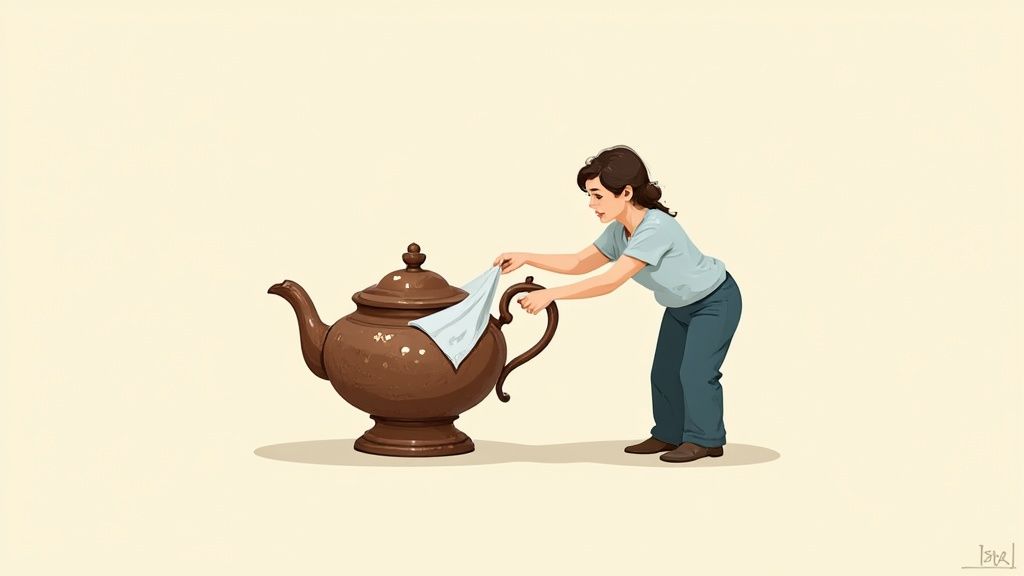
The real thrill of selling vintage begins with the hunt. To run a successful shop, you have to develop a keen eye and move past just wandering aimlessly through thrift stores. The goal is to spot the high-quality, in-demand pieces that most people walk right past.
This means getting strategic about how you uncover those hidden gems. Sourcing is a skill you cultivate over time—a blend of patience, deep knowledge, and a little bit of gut instinct. It’s all about knowing where to look and, more importantly, what you’re looking for.
Mastering the Art of Sourcing
To find the best inventory, you need to go where the good stuff is. While a lucky thrift store find is always a rush, you’ll get more consistent results by focusing on more curated or time-sensitive events.
Estate sales are, without a doubt, one of the best sources for authentic, high-quality vintage. You’re looking at the entire contents of a home, often with beautifully preserved items from specific eras. It’s like stepping into a time capsule, with everything from mid-century modern furniture to genuine period clothing all in one place. Getting the most out of these sales requires a solid plan. For a complete game plan, check out our essential estate sale tips to learn how to prepare and snag the best deals.
Flea markets and antique fairs are another fantastic hunting ground. You're often buying from other dealers and seasoned collectors, which means a lot of the items are already pre-vetted. My advice? Get there at the crack of dawn for the best selection, but don’t be afraid to stick around until closing time. That’s when you’ll find sellers eager to unload their remaining stock at a great price.
And don’t overlook online auctions and local classifieds. Websites like eBay or local estate auction portals can be absolute goldmines, especially if you’re looking for niche collectibles. A pro tip is to set up keyword alerts for your specialty so you get notified the second a promising new item is listed.
A Pro's Insight: I never leave home without my "sourcing kit" in the car. It’s nothing fancy, just a bag with cash in small bills, a tape measure, a jeweler's loupe, and some extra bags and boxes. Being prepared lets you act fast when you stumble upon that perfect, can't-miss item.
Developing Your Expert Eye
Sourcing is more than just being in the right place at the right time—it's about recognizing potential. As you get more experience selling vintage, you'll start to see profit where others just see clutter. This "expert eye" is a muscle you have to build through practice and constant research.
Here are a few things to train your eye to spot:
- Maker's Marks: Always flip things over. Look for signatures, stamps, or labels on the bottom of ceramics, inside furniture drawers, or on clothing tags. These marks are your first and best clue to an item's origin.
- Construction Details: Pay attention to how an item was made. Is that t-shirt single-stitched? Is the furniture joined with dovetails instead of staples? These details are dead giveaways for older, better-quality craftsmanship.
- Material Feel: The weight and texture of an item can tell you a lot. Old glass often feels heavier. Certain vintage fabrics have a distinct hand-feel. Real wood has a density and heft that modern particleboard just can't replicate.
The Critical Importance of Authentication
Once you’ve found a potential treasure, the next crucial step is making sure it’s the real deal. Authentication is the very foundation of a trustworthy vintage business. Your customers are counting on your expertise, so being completely transparent about an item's history and condition isn't just good practice—it's everything.
With the boom in vintage selling, the risk of counterfeits has grown, especially for high-value collectibles. Properly authenticating your finds is vital for protecting both your reputation and your bottom line.
So, how do you do it? Start by digging deeper into the details you spotted while sourcing. That maker's mark is your first breadcrumb. Use online resources, collector's guides, or even authentication apps to identify the mark and learn more about the piece. Look closely for honest signs of age, or patina. Things like crazing on pottery or gentle fading on fabric are good signs. Faked aging often looks too perfect or uniform.
Finally, just be honest. If you can't definitively date a piece, say so. If an item has flaws, take clear, well-lit photos of them. Your buyers will always appreciate honesty more than they expect perfection. When you build a reputation for accurate and truthful listings, you create a loyal customer base that will come back again and again because they trust your eye—and your word.
Prepping and Photographing Your Finds for a Quick Sale
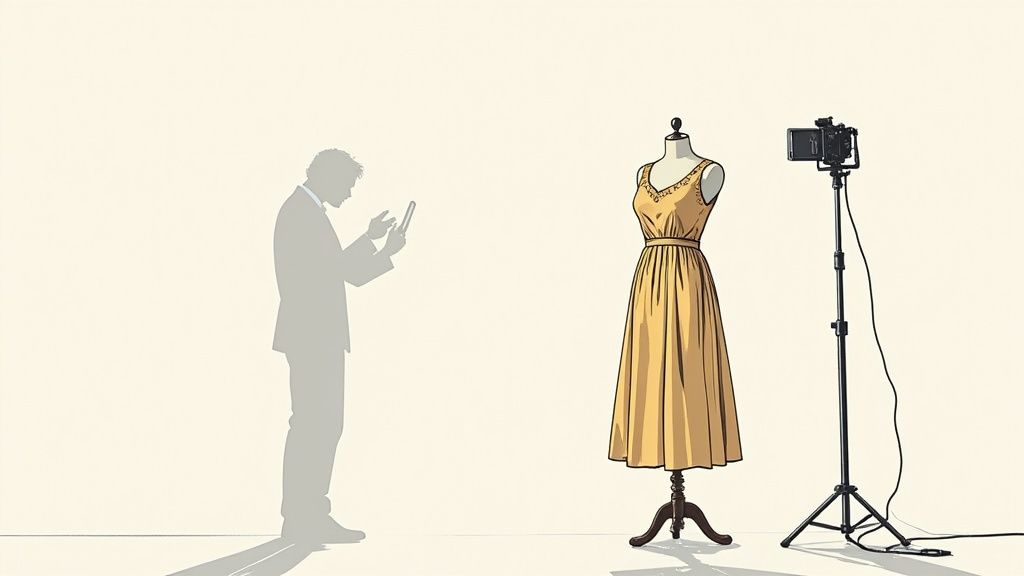 Once you've snagged a potential treasure, its journey to a new home is only halfway over. How you get that item ready for its close-up is what transforms a good find into a must-have piece. It's the difference between an item that sits for months and one that sells in days.
Once you've snagged a potential treasure, its journey to a new home is only halfway over. How you get that item ready for its close-up is what transforms a good find into a must-have piece. It's the difference between an item that sits for months and one that sells in days.
Great presentation isn't about fooling anyone into thinking something old is brand new. It's about celebrating its unique character. This really comes down to two things: thoughtful cleaning and stellar photography. These are the skills that separate the amateurs from the pros and are absolutely critical for building the kind of trust that creates repeat customers.
To Clean or Not to Clean
This is the first question every new seller grapples with. Should you scrub it down or leave that beautiful, aged look intact? Honestly, the answer almost always depends on the item's material and history. Knowing when a gentle polish is in order versus when to preserve that natural patina is a skill you'll hone as you learn how to sell vintage items effectively.
For a lot of pieces, a careful cleaning is a must. Nobody wants to buy a dusty serving dish or grimy glassware. But sometimes, being too aggressive can literally strip an item of its value.
- Durable Goods: Things like glassware, ceramics, and sturdy kitchenware almost always benefit from a gentle bath with mild soap and water. It just removes the surface dirt and makes the item feel fresh and ready to use.
- Textiles: For vintage clothing or old linens, always check for a care label first. If there isn't one, a quick search for the fabric type will tell you what to do. Delicate materials like silk and wool often need a trip to a specialist dry cleaner, while many cottons can handle a careful hand wash. Even a simple steaming can work wonders to remove wrinkles and musty smells without resorting to harsh chemicals.
- Wood and Metal: Now this is where it gets tricky, and the word patina becomes your guide. Polishing a piece of antique silver can reveal its original glimmer and significantly increase its appeal. But for something like an old brass lamp or a rustic wooden chest, that aged, weathered surface is the charm. Over-clean it, and you can make it look unnaturally new, tanking its value in the process.
A good rule of thumb is to always start with the least invasive method. A soft, dry cloth can do wonders for surface dust without harming the finish. When in doubt, it's far better to under-clean than to over-clean. You can always add a note in your description like, "Item has its original patina and may benefit from a more thorough cleaning by the new owner."
Mastering Your Smartphone Camera
Let's be clear: you do not need a high-end DSLR to take photos that sell. Your smartphone is more than capable of producing professional-looking images that will make your listings pop. The secret isn't the gear; it's the setup.
Natural light is your best friend. Find a spot near a large window that gets bright, indirect light. Direct sun is your enemy—it creates harsh shadows that hide important details. Next, you need a simple, neutral background. This could be a plain white wall, a sheet of poster board from the dollar store, or even a clean, ironed bedsheet. Your only goal here is to eliminate distractions so the item is the star of the show.
And my best advice? Take way more photos than you think you need. Get every single angle. Give the buyer a complete 360-degree view of the piece.
The Essential Shots That Actually Sell
Your photos need to replicate the experience of a buyer picking an item up and examining it in person. A robust photo gallery answers questions before they're even asked, which builds confidence and dramatically cuts down on returns.
Make sure your photoshoot always includes these key shots:
- The Hero Shot: This is your money shot. A beautifully styled, perfectly lit photo of the item that serves as your main image.
- Scale and Context: Show the item next to a common object, like a coin or even your hand, to give people an instant sense of its size. A simple lifestyle shot can also help them visualize it in their own space.
- Detailed Close-Ups: Get right in there. Zoom in on unique features like a maker's mark, intricate stitching, original hardware, or interesting textures. These are the details collectors love.
- The Flaws (Yes, Really): This part is non-negotiable. Be radically transparent. Take clear, brightly lit photos of any and all imperfections—chips, stains, cracks, or wear. Honesty doesn't scare away serious buyers; it proves you're a trustworthy seller they can rely on.
By taking the time to prep and photograph your items with care, you aren't just listing a product. You're presenting a curated piece with a history. This thoughtful approach is exactly how you turn a fun vintage-hunting hobby into a thriving business.
Crafting Your Listing and Choosing Where to Sell
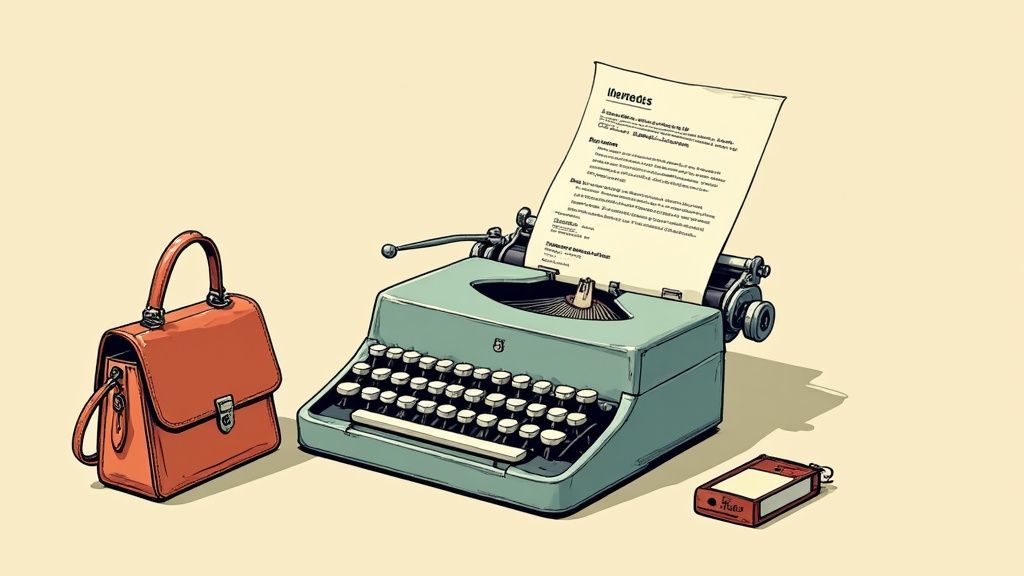
You’ve done the heavy lifting—hunting, cleaning, and taking beautiful photos of your finds. Now comes the exciting part: getting those treasures in front of people who will love them. This is where all your hard work pays off, but it's also where two crucial decisions can make or break a sale: where you list your items and how you describe them.
Think of it this way: the right platform puts you in a room full of your ideal customers, and a great listing is your one-on-one conversation with each of them. Nailing these two elements is how you build a real, profitable vintage business instead of just a hobby.
Picking the Perfect Platform
Choosing where to sell your vintage goods is a big deal. It affects who sees your items, how much you pay in fees, and the overall vibe of your shop. There’s no single "best" answer here—the right choice really depends on what you're selling and what your long-term goals are.
Some sellers love the built-in traffic of a huge marketplace, while others want the freedom of their own branded website, away from direct competitors. The good news is the entire second-hand market is exploding. It's projected to jump from $424.1 billion to nearly $479 billion in a single year, largely thanks to online platforms. This trend is creating massive opportunities for sellers, which you can learn more about in this market report.
Let's look at the main players to help you figure out where you fit in.
Comparison of Top Platforms for Selling Vintage Items
Navigating the world of online marketplaces can be overwhelming. Each platform caters to a different audience and has its own fee structure and features. This table breaks down the most popular options to help you decide where to plant your flag.
| Platform | Best For | Typical Fees (Example) | Key Selling Point |
|---|---|---|---|
| Etsy | Curated vintage clothing, home decor, jewelry, and unique collectibles. | $0.20 listing fee + 6.5% transaction fee. | A large, built-in audience actively searching for vintage and handmade goods. |
| eBay | A massive range of items, from rare collectibles and electronics to everyday vintage. | Varies by category; typically ~13.25% on most items + $0.30. | Unmatched global reach and the option for auction-style listings for high-demand items. |
| Depop | Y2K fashion, streetwear, and trendy vintage aimed at a younger demographic. | 10% Depop fee + payment processing fee. | A social, mobile-first interface that helps you build a personal brand. |
| Shopify | Sellers ready to build a distinct brand and have full control over their business. | Monthly subscription (starts at ~$29/mo) + payment processing fees. | Total creative control and direct customer relationships with no marketplace fees. |
Ultimately, the best platform is the one that aligns with your specific niche and business ambitions. Don't be afraid to start on one and expand to others as you grow.
A smart strategy many successful sellers use is to start on a marketplace like Etsy or Depop. You can test your products, build a following, and generate cash flow. Once you've got momentum, launching your own Shopify store allows you to own your customer relationships and escape marketplace fees.
How to Write Product Listings That Sell
Your product listing is your 24/7 salesperson. It needs to do more than just state the facts—it has to tell a story, build trust, and help a buyer imagine your item in their own life. This is your moment to let your expertise and passion shine through.
Crafting a Title That Attracts Clicks
Your title is your first impression. To get noticed, you need to think like a buyer. What specific words would they use to find your item? A title packed with relevant keywords is your ticket to showing up in their search results.
A simple, effective formula I always come back to is: Era/Style + Material + Item Type + Key Feature
- Don't write: "Old Blue Dress"
- Instead, try: "1970s Vintage Blue Floral Maxi Dress with Ruffle Collar"
See the difference? The second title is a powerhouse. It instantly tells a shopper the era, color, pattern, item type, and a unique detail, answering their questions before they even click.
Weaving a Compelling Story in Your Description
Once they've clicked, your description needs to seal the deal. This is where you bring the piece to life.
- Lead with the Facts: Always start with the non-negotiables: precise measurements, materials, and a brutally honest assessment of the condition. Mention every tiny flaw. It might feel counterintuitive, but this transparency is how you build rock-solid trust with buyers.
- Tell Its Story: This is the fun part. What makes this piece special? Is there any known history? Use descriptive, evocative language. Instead of just "a glass bowl," try something like, "This heavy, Depression-era pink glass bowl catches the light beautifully—a perfect statement piece for a modern dining table."
- Offer Styling Inspiration: Help them see it in their world. If it's a vintage blouse, suggest pairing it with high-waisted jeans for a classic look. If it's a piece of decor, describe how it could add character to a minimalist shelf. This little step closes the gap between seeing a vintage item and wanting it for themselves.
By choosing your platform wisely and mastering the art of the listing, you give your sourced treasures the very best chance to find a happy new home.
Nailing Your Pricing and Shipping Strategy
So, you’ve sourced your vintage treasures, photographed them beautifully, and written descriptions that tell their stories. Now comes the part that turns your passion project into a real, profitable business: pricing and shipping. It might not have the thrill of the hunt, but getting these two elements right is the foundation of a sustainable vintage shop.
This is where you ensure you're paid fairly for your time and expertise. It's how you keep customers happy and coming back. Master these operational details, and you'll be set up for long-term success.
How to Price Your Vintage Items with Confidence
Let's be honest, pricing can be nerve-wracking. You’re caught between pricing too high and scaring off buyers, or pricing too low and cheating yourself. The goal is to find that perfect sweet spot—the price that reflects the item's true market value while covering your costs and leaving you with a healthy profit.
Your best friend in this process? Research. Start by digging into comparable sales, or "comps." Platforms like eBay and Etsy are goldmines for this. The trick is to use their search filters to look at sold listings only. What people are actually paying for an item is a much more reliable indicator of value than what other sellers are simply asking.
When you're looking at comps, you have to be a bit of a detective. Consider these key factors:
- Condition: Is your piece in pristine, mint condition, or does it show its age? Be honest and adjust your price up or down compared to the sold listings you find.
- Rarity: Are there dozens of these for sale, or is yours a rare bird? Scarcity naturally increases value.
- Label or Brand: A piece from a well-known designer or a highly sought-after brand will always fetch a higher price.
- Demand: Is this particular style or item having a moment? A quick search on Google Trends can reveal if an item is currently trending, which can justify a higher price point.
A Quick Reality Check: Pricing is as much an art as it is a science. Always remember to factor in what you paid for the item, any money spent on cleaning or repairs, platform fees, and, most importantly, the value of your own time. Your final price needs to cover all of that and still give you room to grow.
If you're looking to go even deeper on valuation, this antique pricing guide is packed with more advanced strategies.
Fixed Price vs. Auction Style
You've also got a choice in how you sell. A fixed price (or "Buy It Now") listing is straightforward. Buyers know the cost upfront and can purchase instantly. For the vast majority of vintage items, this is the way to go. It’s clean, simple, and moves inventory.
However, if you've stumbled upon something truly exceptional—a rare designer handbag, a first-edition book with a cult following—an auction-style listing can work wonders. The competition and sense of urgency an auction creates can drive the final price well beyond what you might have asked for it. Reserve this for those truly special, high-demand pieces.
Making Sense of the Shipping Maze
Shipping can feel like the final, daunting hurdle. But with a solid strategy, you can turn it into a strength. You have two main goals here: get the item to your customer safely, and calculate the cost accurately so you don't lose your hard-earned profit. A broken item means a refund and a disappointed customer—two things that can seriously harm your shop's reputation.
First things first: invest in good packing materials. This is not the place to cut corners.
- Sturdy Boxes: Always use new or nearly new corrugated boxes that can withstand a bit of rough handling.
- Bubble Wrap & Packing Paper: Be generous. You want to cushion the item from every angle.
- Packing Peanuts or Air Pillows: These are perfect for filling voids in the box to stop the item from shifting around.
- "Fragile" Stickers: They really do make a difference and signal to handlers to take extra care.
Once you have your supplies, you need to figure out the cost. The only way to do this with real accuracy is to weigh and measure your item after it's been completely packed for shipping. Then, pop those numbers into the shipping calculator on your chosen carrier's website, like USPS, UPS, or FedEx. This will give you a precise cost based on weight, size, and destination.
The "Free Shipping" Advantage
Offering free shipping is a powerful psychological tool. In fact, studies show that more than 70% of online shoppers are more inclined to make a purchase if shipping is free. Of course, "free" shipping is never actually free for you, the seller. You have to account for that cost.
Here are two smart ways to offer it without tanking your profits:
- Bake the Cost into the Price: Calculate your average shipping cost for an item and gently increase the list price to cover it. The buyer gets the satisfaction of "free" shipping, and your profit margin stays intact.
- Set a Minimum Order Value: Offer free shipping on orders over a specific amount, like $50 or $75. This is a brilliant way to encourage shoppers to add another item or two to their cart, boosting your average sale.
By creating a clear system for your pricing and a reliable plan for shipping, you take the anxiety and guesswork out of your daily operations. This frees you up to focus on the fun part: discovering amazing vintage pieces and sharing their history with the world.
Common Questions About Selling Vintage Items
Jumping into the vintage world is exciting, but let's be honest—it also comes with a lot of questions. As you get started, you'll inevitably run into situations that feel a bit tricky or unfamiliar. This FAQ is designed to give you straightforward answers to those common sticking points, so you can handle them with confidence.Think of this as your go-to resource for those "what should I do?" moments. Getting these basics right is how you build a solid, trustworthy business from day one.
How Do I Know If an Item Is Truly Vintage?
This is probably the most fundamental question, and for good reason. Generally, an item is considered vintage if it's between 20 and 99 years old. Once it hits the 100-year mark, it officially graduates to antique status.
So, how do you verify an item's age? You have to become a bit of a detective. Start by looking for clues that point to its origin and era:
- Maker's Marks and Labels: Look for company logos, stamps, or union labels on clothing. A quick online search of these marks can often pinpoint a production date.
- Construction Techniques: The way something was made is a huge tell. For example, the single-stitching on the sleeves and hem of a t-shirt is a classic hallmark of pre-1990s manufacturing.
- Materials Used: Certain plastics, fabrics, and even types of metal hardware were only popular during specific decades.
Comparing your item to verified examples in online archives, collector forums, or reference books is another fantastic way to confirm you’ve got the real deal.
What Vintage Categories Are Most Profitable?
While trends can be fickle, some niches consistently have strong demand and bring in healthy profits. The best strategy is to find a profitable category that you're genuinely passionate about.
Right now, mid-century modern furniture and decor are still incredibly popular. Other categories that tend to sell well include:
- Vintage designer handbags from established luxury brands.
- Band t-shirts and streetwear, especially from the 1970s through the 1990s.
- Unique or signed costume jewelry and fine jewelry pieces.
Your expertise is your biggest advantage here. The more you know about a specific category, the better you'll get at sourcing high-quality pieces and writing listings that sell.
A huge part of profitability comes down to smart pricing, which isn't always easy with one-of-a-kind finds. The principles are very similar to other resale markets, so learning how to price estate sale items can give you a solid foundation for valuing your vintage inventory.
Should I Clean an Item or Sell It As-Is?
This is a delicate dance every seller has to learn. For durable things like most glassware, ceramics, or sturdy textiles, a gentle cleaning can dramatically increase their appeal and value. Wiping away decades of dust and grime makes the item instantly more attractive to potential buyers.
However, you have to be careful. For some items, the patina—that beautiful, natural finish that only develops with age—is a massive part of its story and value. Over-cleaning an antique metal box, a rustic wooden trunk, or certain collectibles can strip away that character and actually lower its worth.
When in doubt, always research the specific item type or do a small spot test on an area no one will see. And no matter what you do, be transparent about any cleaning or repairs in your item description. Honesty always wins in this business.
Feeling inspired to uncover the stories behind your own vintage finds? Curio is the perfect tool for any aspiring seller. Just snap a photo, and our app instantly provides you with an item's history, origin, and an estimated market value. Stop guessing and start knowing. Download Curio today and turn your treasures into a thriving business.
